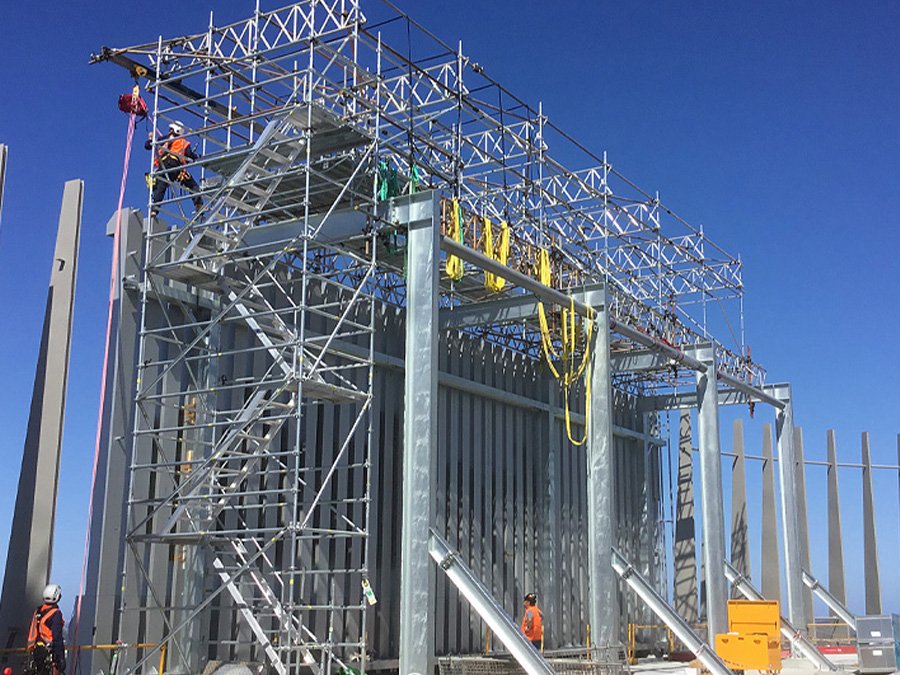Temporary Roof Scaffolding to Ensure Safe Working Conditions During Projects
Temporary Roof Scaffolding to Ensure Safe Working Conditions During Projects
Blog Article
Checking Out the Different Sorts Of Scaffolding Utilized in Construction Tasks
The building industry relies greatly on numerous kinds of scaffolding to satisfy specific task needs, each offering distinctive benefits and applications. Typical framework scaffolding gives a strong structure for general tasks, while suspended scaffolding is important for job on high-rise structures.

Traditional Frame Scaffolding
Typical framework scaffolding is just one of one of the most widely utilized techniques in the building and construction industry due to its effectiveness and convenience. This system is composed of horizontal and upright frameworks that are assembled to create a secure platform for employees and materials. The main components include vertical posts, straight journals, and diagonal braces, which with each other supply a strong structure that can sustain considerable tons.
Among the crucial advantages of traditional framework scaffolding is its versatility to numerous building tasks, ranging from residential structures to big business structures. The modular design permits very easy assembly and disassembly, making it effective for both short-term and lasting projects. In addition, the system can be customized in height and size, suiting different building designs and website problems.
Security is vital in scaffolding applications, and conventional frame systems are furnished with guardrails and toe boards to stop falls and ensure employee defense. Additionally, regular evaluations and adherence to security laws are important in keeping the honesty of the scaffold. On the whole, traditional framework scaffolding continues to be an essential option in the building and construction industry, providing a trusted system for labor and improving total project effectiveness

Suspended Scaffolding
Suspended scaffolding offers a special option for building tasks that need access to raised surfaces, particularly in circumstances where typical structure scaffolding may be unwise. This type of scaffolding is commonly put on hold from the roof or top degrees of a structure, making use of a system of ropes, wheels, and systems to develop a working area that can be adapted to different elevations.
One of the main advantages of put on hold scaffolding is its versatility. It can be easily repositioned or decreased to suit changes in building needs, making it excellent for jobs such as window installment, frontage job, and maintenance on high-rise buildings. Furthermore, the marginal footprint of suspended scaffolding enables far better use ground space in city environments, where space is commonly restricted.
Security is a vital factor to consider in using put on hold scaffolding. Proper rigging and securing systems need to be utilized to ensure stability and protect against accidents. Operators has to also be learnt the safe use this tools. Overall, suspended scaffolding provides a efficient and reliable remedy for accessing hard-to-reach areas in numerous building scenarios, enhancing both productivity and safety and security on site.
System Scaffolding
System scaffolding, often considered a modern remedy in the scaffolding sector, contains pre-engineered components that can be rapidly put together and adapted for different construction projects. Scaffolding. This sort of scaffolding is identified by its modular layout, which permits for flexibility and effectiveness on work websites, suiting different elevations and structural requirements
Normally made from high-strength steel or light weight aluminum, system scaffolding supplies improved sturdiness and stability. The components include upright messages, horizontal ledgers, and diagonal braces, which interconnect securely, making sure a durable structure. The style usually integrates standardized installations, streamlining setting up and disassembly procedures, therefore minimizing labor time and expenses.

Rolling Scaffolding
Rolling scaffolding is a flexible choice to conventional fixed scaffolding, designed for wheelchair and ease of usage on building and construction websites. This sort of scaffolding contains a platform supported by frames with wheels, permitting workers to easily relocate it as needed. The mobility function significantly boosts performance, as it lessens downtime related to disassembling and constructing dealt with scaffolding.
Normally constructed from light-weight products such as light weight aluminum or steel, rolling scaffolding uses a durable yet mobile service for jobs calling for frequent repositioning - Scaffolding. It is particularly advantageous in tasks such as painting, drywall installment, and electrical work, where accessibility to different heights and areas is necessary
Safety and security is paramount in rolling scaffolding design, with features such as locking wheels to stop unintentional activity when in operation, and guardrails to shield workers from falls. Additionally, numerous designs are flexible in height, suiting various project requirements.
Cantilever Scaffolding

The design of best site cantilever scaffolding generally involves using braces or arms anchored to a structure or framework, enabling the platform to expand exterior securely. Safety and security is extremely important; thus, these scaffolds need to be crafted to stand look what i found up to different lots and ecological problems. Normal assessment and maintenance are crucial to make sure architectural stability and employee security.
Cantilever scaffolding is favored for its convenience and effective use room, making it a popular choice in urban settings where space restraints prevail. Furthermore, it promotes less complicated access to high elevations, inevitably adding to the total performance of building tasks. As with all scaffolding kinds, proper training and adherence to safety criteria are essential for employees using cantilever scaffolding.
Conclusion
Traditional frame scaffolding provides stability, while suspended scaffolding offers versatility for raised tasks. System scaffolding helps with fast setting up, and rolling scaffolding improves wheelchair for differing job atmospheres.
Standard frame scaffolding supplies a durable foundation for basic tasks, while put on hold scaffolding is important for job on high-rise structures.Rolling scaffolding is a versatile alternative to conventional fixed scaffolding, developed for flexibility and convenience of usage on construction sites. As with all scaffolding kinds, correct training and adherence to see page safety and security requirements are crucial for employees using cantilever scaffolding.
Standard framework scaffolding offers security, while put on hold scaffolding provides flexibility for elevated jobs. System scaffolding promotes quick setting up, and rolling scaffolding boosts movement for differing work settings.
Report this page